
- Home
- Travel Packages
- Top Destination
-
Travel Attraction
By Category
Top Attraction

- Travel Agents
- Car Rentals
- Hotels
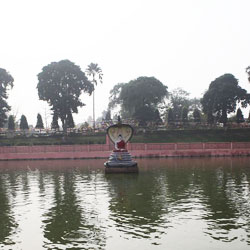
About The Bodhi Sarovar Temple The Bodhi Sarovar Temple, located in Bodhgaya, is a significant religious site for Buddhists around the world. The temple is situated near the Mahabodhi Temple Complex, which is a UNESCO World Heritage Site. Bodhi Sarovar Temple is known for its tranquil surroundings and the sacred Bodhi tree, under which Lord Buddha is believed to have attained enlightenment. Architecture of Bodhi Sarovar Temple The Bodhi Sarovar Temple features traditional Indian temple architecture with intricate carvings and designs. The temple is surrounded by a large pond, known as the Sarovar, which adds to the serenity of the place. The temple complex also houses statues of Lord Buddha and other deities, making it a peaceful place for meditation and prayer. History The Bodhi Sarovar Temple has a rich history dating back to ancient times. It is believed that the temple was built on the site where Lord Buddha spent seven days after attaining enlightenment. The Sarovar, or pond, is said to have healing properties, and pilgrims from around the world come to bathe in its waters for spiritual cleansing. Best Time To Visit The best time to visit the Bodhi Sarovar Temple is during the winter months, from October to March, when the weather is pleasant and conducive to outdoor activities. The temple complex is less crowded during this time, allowing visitors to explore the site peacefully and soak in the spiritual atmosphere. How To Reach The Bodhi Sarovar Temple is located in Bodhgaya, Bihar, which is well-connected by road, rail, and air. The nearest airport is Gaya Airport, which is about 10 kilometers away from the temple. The nearest railway station is Gaya Junction, which is well-connected to major cities in India. Visitors can also hire taxis or take local buses to reach the temple complex. Significance Of The Bodhi Sarovar Temple The Bodhi Sarovar Temple holds great significance for Buddhists as it is believed to be the place where Lord Buddha spent time in meditation after attaining enlightenment. The Sarovar, or pond, is considered sacred and is believed to have healing powers. Pilgrims from all over the world visit the temple to seek blessings, meditate, and bathe in the holy waters. The peaceful ambiance of the temple complex makes it a perfect place for spiritual reflection and introspection. In conclusion, the Bodhi Sarovar Temple in Bodhgaya is a must-visit destination for those seeking spiritual solace and enlightenment. With its rich history, beautiful architecture, and serene surroundings, the temple complex offers a unique and tranquil experience for visitors. Whether you are a devout Buddhist or simply seeking a peaceful retreat, the Bodhi Sarovar Temple is a place that will leave you feeling rejuvenated and connected to your inner self.
Explore More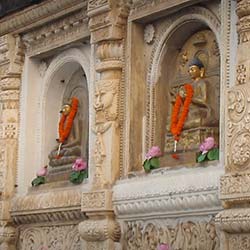
About Mahabodhi Temple, Bodhgaya Bodhgaya, located in the state of Bihar, India, is famous as the place where Prince Siddhartha Gautama attained enlightenment and became the Buddha. The Mahabodhi Temple in Bodhgaya is a UNESCO World Heritage Site and is considered one of the holiest Buddhist pilgrimage sites in the world. History, Architecture, and Design The Mahabodhi Temple was originally built by Emperor Ashoka in the 3rd century BC to commemorate the Buddha's enlightenment. The current temple, however, dates back to the 5th-6th century AD and is a fine example of Indian brickwork and sculptural art. The architecture reflects a blend of Indian, Chinese, and Burmese styles, with a central tower rising to a height of 55 meters. Best Time to Visit The best time to visit the Mahabodhi Temple is during the winter months from October to March when the weather is pleasant and conducive for exploring the complex. Avoid visiting during the summer months as the temperatures can soar and make sightseeing uncomfortable. Cultural Significance The Mahabodhi Temple holds immense cultural significance as the place where the Buddha achieved enlightenment. It is a sacred site for Buddhists around the world and attracts pilgrims and tourists alike. The temple complex also houses a sacred Bodhi tree, which is believed to be a direct descendant of the tree under which the Buddha meditated. Pilgrimage Practices Pilgrims visiting the Mahabodhi Temple often perform rituals such as circumambulating the temple, offering prayers, and meditating under the Bodhi tree. It is a place for reflection, meditation, and seeking spiritual enlightenment. Pilgrims also offer flowers, incense, and candles as offerings to the Buddha. Dress Code and Etiquette Visitors are required to dress modestly and respectfully when visiting the Mahabodhi Temple. Avoid wearing revealing clothing or shorts, and remember to remove your shoes before entering the temple complex. Silence and respect for the sacredness of the site are also important. Activities and Experiences Visitors to the Mahabodhi Temple can participate in meditation sessions, attend Buddhist teachings, and explore the temple complex and its surrounding gardens. The temple also hosts various cultural events and ceremonies throughout the year, providing visitors with a rich and immersive experience. Art and Religious Symbols The Mahabodhi Temple is adorned with intricate carvings, sculptures, and reliefs depicting scenes from the life of the Buddha and various Buddhist deities. The temple's architecture and design are rich in symbolism and serve as a visual representation of Buddhist beliefs and teachings. Local Insights Locals in Bodhgaya are deeply connected to the Mahabodhi Temple and often participate in the daily rituals and ceremonies held at the site. Visiting during festivals such as Buddha Purnima or the Dalai Lama's teachings can provide a unique insight into the local culture and traditions. Interacting with locals and attending local events can enhance your overall experience of Bodhgaya.
Explore More
About the Bodhi Tree, Bodhgaya History The Bodhi Tree in Bodhgaya is believed to be the exact spot where Siddhartha Gautama, the Buddha, attained enlightenment over 2,500 years ago. The tree is a descendant of the original tree under which the Buddha meditated. It has since become a sacred site for Buddhists from around the world. Architecture and Design The Bodhi Tree is a majestic fig tree that stands within the Mahabodhi Temple complex. The temple itself is a magnificent example of ancient Indian architecture, with intricate carvings and sculptures depicting the life of the Buddha. The tree is surrounded by a low fence to protect its roots, and devotees can meditate under its branches. Best Time to Visit Cultural Significance The Bodhi Tree is considered one of the most important Buddhist pilgrimage sites in the world. It symbolizes the Buddha's enlightenment and serves as a focal point for meditation and prayer. Pilgrims from all over the world come to Bodhgaya to pay their respects to the tree and seek spiritual enlightenment. Pilgrimage Practices Visitors to the Bodhi Tree often participate in traditional Buddhist rituals, such as offering incense, flowers, and prayers. Many pilgrims also choose to circumambulate the tree, walking in a clockwise direction as a sign of respect. Some may spend hours meditating under the tree, seeking inner peace and enlightenment. Dress Code and Etiquette When visiting the Bodhi Tree, it is important to dress modestly and respectfully. Both men and women should cover their shoulders and legs, and remove shoes before entering the temple complex. Silence and mindfulness are encouraged, as the site is considered a place of contemplation and spiritual reflection. Activities and Experiences Art and Religious Symbols The Bodhi Tree and the Mahabodhi Temple are adorned with intricate carvings and statues that depict scenes from the life of the Buddha. These artistic representations serve as a visual reminder of the teachings of Buddhism and the importance of enlightenment. The tree itself is a living symbol of growth and transformation. Local Insights Local guides and monks are often available to provide insight into the history and significance of the Bodhi Tree. They can offer spiritual guidance and answer questions about Buddhist practices and beliefs. Visitors can also explore the nearby villages and markets to experience local culture and cuisine, gaining a deeper understanding of the region's traditions and way of life.
Explore More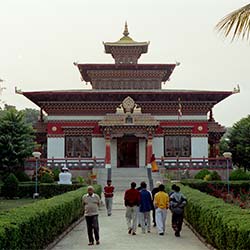
About the Chinese Temple in Bodhgaya History, Architecture, and Design The Chinese Temple in Bodhgaya, also known as the Indosan Nippon Japanese Temple, is a peaceful and beautifully designed structure that serves as a place of worship and meditation for Buddhist practitioners. The temple was built in the 1970s with contributions from various countries, including China, Japan, and India. The architecture of the temple blends traditional Chinese and Japanese design elements, creating a unique and tranquil space for visitors to explore and reflect. Best Time to Visit The best time to visit the Chinese Temple in Bodhgaya is during the winter months, from October to March, when the weather is cool and pleasant. This time of year is ideal for exploring the temple grounds and participating in meditation and prayer sessions without the heat and humidity of the summer months. Cultural Significance The Chinese Temple holds great cultural significance for Buddhists around the world, as it is located in Bodhgaya, the site where Siddhartha Gautama, the Buddha, attained enlightenment. The temple is a place of pilgrimage and spiritual retreat for those seeking to deepen their connection to the teachings of Buddhism and honor the historical importance of Bodhgaya. Pilgrimage Practices Many Buddhists visit the Chinese Temple in Bodhgaya as part of a pilgrimage to important Buddhist sites in India. Pilgrims often participate in meditation, prayer, and ritual practices at the temple, seeking spiritual renewal and enlightenment. Visiting the temple is a way for Buddhists to connect with the teachings of the Buddha and deepen their understanding of the path to enlightenment. Dress Code and Etiquette Visitors to the Chinese Temple in Bodhgaya are expected to dress modestly and respectfully, covering their shoulders and knees. It is customary to remove your shoes before entering the temple and to conduct yourself quietly and respectfully while on the temple grounds. It is important to follow the instructions of temple staff and to avoid taking photographs in areas where it is prohibited. Activities and Experiences Visitors to the Chinese Temple in Bodhgaya can participate in a variety of activities and experiences, including meditation sessions, prayer ceremonies, and cultural performances. The temple grounds offer a peaceful and serene environment for contemplation and reflection, with beautiful gardens and ornate statues that create a sense of tranquility and spiritual connection. Art and Religious Symbols The Chinese Temple is adorned with beautiful artwork and religious symbols that hold deep significance for Buddhist practitioners. Intricate carvings, colorful murals, and statues of Buddhas and Bodhisattvas can be found throughout the temple, creating a visually stunning and spiritually inspiring environment for visitors to explore and appreciate. Local Insights Local residents and monks in Bodhgaya provide valuable insights and perspectives on the Chinese Temple, sharing the history and significance of the temple as well as offering guidance on how to best experience and appreciate the spiritual and cultural aspects of the site. Engaging with locals can enhance your visit to the temple and deepen your understanding of the Buddhist traditions and practices that are observed there.
Explore More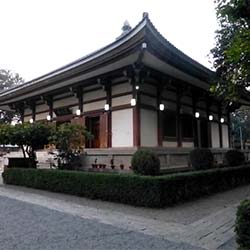
Indosan Nippon Japanese Temple
About Indosan Nippon Japanese Temple, Bodhgaya History The Indosan Nippon Japanese Temple, also known as the Japanese Buddhist Temple, is a tranquil sanctuary located in Bodhgaya, India. The temple was built in 1972 by the Japanese Buddhist monk Nichidatsu Fujii, in collaboration with Indian and Japanese governments. It serves as a symbol of the strong cultural and religious ties between Japan and India. Architecture and Design The Indosan Nippon Japanese Temple features traditional Japanese architectural elements such as a pagoda-style roof, wooden lattice windows, and intricate carvings. The serene garden surrounding the temple adds to its peaceful ambiance and makes it a perfect place for meditation and reflection. Best Time to Visit The best time to visit the Indosan Nippon Japanese Temple is during the winter months from October to March when the weather is pleasant and ideal for exploring the temple grounds. Avoid visiting during the summer months as the temperatures can be scorching hot. Cultural Significance The Japanese Buddhist Temple holds great cultural significance as a place of worship and spiritual practice for followers of Buddhism. It is a sanctuary for pilgrims seeking enlightenment and inner peace, and a symbol of the enduring friendship between Japan and India. Pilgrimage Practices Pilgrims visiting the Indosan Nippon Japanese Temple often engage in meditation, chanting, and offering prayers at the temple. It is a sacred place where devotees can connect with their spiritual beliefs and seek guidance on their path to enlightenment. Dress Code and Etiquette Visitors are required to dress modestly and remove their shoes before entering the temple premises as a sign of respect. It is important to maintain silence and avoid any disruptive behavior while inside the temple to ensure a peaceful environment for meditation and prayer. Activities and Experiences Visitors to the Indosan Nippon Japanese Temple can participate in meditation sessions, attend prayer ceremonies, and explore the beautiful garden surrounding the temple. The serene atmosphere of the temple provides a perfect setting for spiritual contemplation and relaxation. Art and Religious Symbols The temple is adorned with various religious symbols and artwork that represent Buddhist teachings and concepts. Intricate carvings, paintings, and sculptures can be found throughout the temple, creating a visually stunning and spiritually inspiring environment for visitors. Local Insights Local residents and guides can provide valuable insights into the history and significance of the Indosan Nippon Japanese Temple, offering a deeper understanding of its cultural and religious importance. Engaging with the local community can enrich the overall experience of visiting this sacred site.
Explore More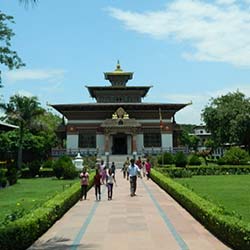
About Royal Bhutan Monastery, Bodhgaya The Royal Bhutan Monastery in Bodhgaya is a beautiful and serene place of worship that holds cultural significance for the Bhutanese people. Its rich history, unique architecture, and peaceful surroundings make it a must-visit destination for those seeking spiritual enlightenment. History The Royal Bhutan Monastery was established in 2003 by the Kingdom of Bhutan as a gift to the Mahabodhi Society of India. It was built to promote peace and harmony among all beings and to honor the teachings of Lord Buddha. The monastery serves as a symbol of the strong bond between Bhutan and India, as well as a beacon of hope for all who seek enlightenment. Architecture and Design The Royal Bhutan Monastery is a stunning example of traditional Bhutanese architecture, with intricate wood carvings, colorful paintings, and ornate decorations. The main temple is adorned with a gold-plated roof and houses a magnificent statue of Buddha. The surrounding gardens and prayer wheels add to the peaceful and meditative atmosphere of the monastery. Best Time to Visit The best time to visit the Royal Bhutan Monastery is during the winter months, from November to February, when the weather is cool and pleasant. This is also the peak tourist season, so you can expect to see the monastery bustling with visitors from all over the world. However, if you prefer a quieter and more peaceful experience, consider visiting during the off-peak months of March to October. Cultural Significance The Royal Bhutan Monastery holds great cultural significance for the Bhutanese people, as it represents their strong ties to Buddhism and their commitment to promoting peace and harmony. The monastery is a place of worship, meditation, and learning, where visitors can immerse themselves in Bhutanese culture and traditions. Pilgrimage Practices Visitors to the Royal Bhutan Monastery are encouraged to participate in traditional pilgrimage practices, such as prostration, circumambulation, and offering prayers and offerings. These practices are believed to purify the mind, body, and soul, and deepen one's connection to the teachings of Buddha. Pilgrims can also receive blessings from the resident monks and take part in special ceremonies and rituals. Dress Code and Etiquette Visitors to the Royal Bhutan Monastery are expected to dress modestly and respectfully, covering their shoulders and knees. Shoes should be removed before entering the temple, and hats and sunglasses should be removed as a sign of respect. Talking loudly, taking photos without permission, and touching or pointing at religious objects are considered disrespectful behaviors and should be avoided. Activities and Experiences Visitors to the Royal Bhutan Monastery can participate in a variety of activities and experiences, such as attending meditation sessions, listening to lectures by resident monks, and taking part in traditional ceremonies and rituals. The monastery also offers guided tours, cultural performances, and workshops on Bhutanese art and handicrafts. Visitors can also explore the surrounding gardens, prayer wheels, and meditation huts for a truly immersive experience. Art and Religious Symbols The Royal Bhutan Monastery is adorned with beautiful art and religious symbols that reflect the rich cultural heritage of Bhutan. Intricate wood carvings, colorful paintings, and ornate decorations depict scenes from the life of Buddha, as well as symbols of peace, wisdom, and compassion. The main temple houses a magnificent statue of Buddha, surrounded by offerings of flowers, candles, and incense. Local Insights Visitors to the Royal Bhutan Monastery can gain valuable insights into Bhutanese culture and traditions by interacting with the resident monks and local devotees. They can learn about the history and significance of the monastery, as well as the daily routines and practices of the monks. Visitors can also explore the nearby villages and markets to experience the local way of life and taste traditional Bhutanese cuisine.
Explore More
About Thai Monastery, Bodhgaya The Thai Monastery in Bodhgaya is a beautiful and serene place of worship for Buddhists from around the world. It holds great historical and cultural significance and is a popular destination for pilgrims seeking spiritual enlightenment. History The Thai Monastery was established in Bodhgaya to commemorate the visit of the King of Thailand in 1956. It was built as a symbol of the strong bond between Thai and Indian Buddhists and serves as a place of meditation and worship for all who visit. Architecture and Design The Thai Monastery features traditional Thai architecture with intricate carvings and colorful decorations. The main hall houses a beautiful statue of the Buddha, surrounded by stunning murals depicting scenes from his life. Best Time to Visit The best time to visit the Thai Monastery in Bodhgaya is during the winter months from November to February when the weather is cooler and more pleasant. This is also the peak season for tourists, so it is advisable to plan your visit in advance. Cultural Significance The Thai Monastery is an important cultural landmark in Bodhgaya, symbolizing the strong ties between Thailand and India. It is a place of spiritual pilgrimage for Buddhists seeking enlightenment and inner peace. Pilgrimage Practices Visitors to the Thai Monastery are encouraged to engage in traditional Buddhist practices such as meditation, chanting, and offering prayers. Pilgrims often circumambulate the main hall three times as a sign of respect and devotion. Dress Code and Etiquette Visitors to the Thai Monastery are required to dress modestly and respectfully. It is recommended to wear clothing that covers the shoulders and knees out of respect for the sacredness of the place. Shoes should also be removed before entering the main hall. Activities and Experiences Visitors to the Thai Monastery can participate in a variety of activities and experiences, including meditation sessions, chanting ceremonies, and teachings by Buddhist monks. The peaceful atmosphere of the monastery provides a perfect setting for self-reflection and spiritual growth. Art and Religious Symbols The Thai Monastery is adorned with beautiful art and religious symbols that hold deep significance in Buddhist culture. Visitors can admire the intricate carvings, paintings, and statues that depict the life and teachings of the Buddha. Local Insights Local residents and monks at the Thai Monastery offer valuable insights into Buddhist practices and traditions. Visitors can engage in meaningful conversations with the locals to gain a deeper understanding of the spiritual significance of the monastery and its teachings.
Explore More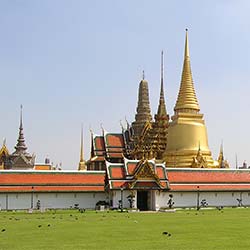
About The Vietnamese Temple The Vietnamese Temple, also known as the Vietnam Phat Quoc Tu temple, is a beautiful and serene Buddhist temple located in Bodhgaya, India. This temple holds great significance for the Vietnamese Buddhist community and serves as a place of worship and meditation for pilgrims and visitors alike. Architecture of Vietnamese Temple The Vietnamese Temple is known for its traditional Vietnamese architecture, with colorful decorations and intricate carvings adorning its façade. The temple features a large prayer hall where devotees can offer their prayers and meditate in peace. The temple grounds also include beautifully landscaped gardens and tranquil ponds, creating a peaceful and spiritual atmosphere for visitors. History The Vietnamese Temple was built in 2002 with the support of the Vietnamese government and the local Buddhist community. It was constructed as a symbol of the strong cultural and spiritual ties between Vietnam and India, the birthplace of Buddhism. The temple has since become a popular destination for Vietnamese pilgrims and tourists seeking spiritual fulfillment and enlightenment. Best Time To Visit The Vietnamese Temple can be visited throughout the year, but the best time to visit is during the winter months from November to February when the weather is cool and pleasant. This is also the peak tourist season in Bodhgaya, so visitors can experience the vibrancy and energy of the place during this time. How To Reach The Vietnamese Temple is located in Bodhgaya, a small town in the state of Bihar, India. The town is well-connected by road, rail, and air, making it easily accessible for visitors. The nearest airport is in Gaya, which is about 7 kilometers away from Bodhgaya. From the airport, visitors can take a taxi or a bus to reach the Vietnamese Temple. Additionally, Bodhgaya has a railway station that is well-connected to major cities in India, making it convenient for travelers to reach the temple by train. Significance Of The Vietnamese Temple The Vietnamese Temple holds great significance for the Vietnamese Buddhist community as a place of worship and spiritual retreat. It serves as a reminder of the rich cultural heritage of Vietnam and the teachings of Buddhism. The temple also plays a key role in promoting peace, harmony, and understanding among people of different cultures and backgrounds. Visitors to the Vietnamese Temple can experience a sense of tranquility and enlightenment as they explore its beautiful surroundings and participate in meditation and prayer sessions. In conclusion, the Vietnamese Temple in Bodhgaya is a place of great spiritual and cultural significance, attracting visitors from all over the world who seek peace, enlightenment, and spiritual fulfillment. With its traditional Vietnamese architecture, lush gardens, and serene atmosphere, the temple offers a unique experience for those looking to connect with their inner selves and explore the teachings of Buddhism. Whether you are a devout Buddhist or simply a curious traveler, a visit to the Vietnamese Temple is sure to leave a lasting impression on your heart and soul.
Explore More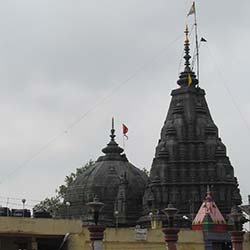
About The Vishnupad Temple The Vishnupad Temple is a renowned Hindu temple located in the sacred town of Bodh Gaya in the state of Bihar, India. This temple is dedicated to Lord Vishnu, one of the principal deities in Hinduism. The name "Vishnupad" translates to "Vishnu's feet," and the temple is famous for housing a footprint of Lord Vishnu himself. Architecture of Vishnupad Temple The Vishnupad Temple showcases impressive architecture that reflects traditional Hindu temple design. The temple is constructed using red sandstone and is adorned with intricate carvings and sculptures. The main sanctum sanctorum houses the sacred footprint of Lord Vishnu, which is believed to be imprinted on a solid rock. History The history of the Vishnupad Temple dates back to ancient times. It is believed that the temple was established by the Maratha ruler, Queen Ahilyabai Holkar, in the 18th century. However, the site has been a place of worship for centuries, with references to the footprint of Lord Vishnu mentioned in various Hindu scriptures and texts. Best Time To Visit The best time to visit the Vishnupad Temple is during the winter months, from October to February, when the weather is pleasant and ideal for exploring the temple complex. Additionally, visiting during religious festivals such as Ram Navami and Diwali can provide a unique cultural experience. How To Reach The Vishnupad Temple is easily accessible by road, rail, and air. The nearest airport is in Gaya, approximately 12 kilometers away from Bodh Gaya. The town is well-connected by rail, with regular trains from major cities like Delhi, Kolkata, and Varanasi. Additionally, several state-run and private buses ply to Bodh Gaya from nearby cities. Significance Of The Vishnupad Temple The Vishnupad Temple holds immense significance for Hindu devotees, who believe that worshipping at the temple grants blessings and fulfillment of desires. The footprint of Lord Vishnu is considered sacred and is believed to possess divine powers. Many pilgrims visit the temple to seek spiritual solace and offer prayers to the deity. Overall, the Vishnupad Temple in Bodh Gaya is a place of great religious and cultural importance, attracting devotees and tourists alike with its rich history, impressive architecture, and spiritual aura. A visit to this temple is sure to be a memorable and enlightening experience for all who come seeking blessings and divine guidance.
Explore More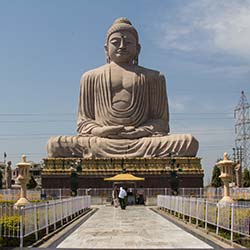
About the Great Buddha Statue, Bodhgaya The Great Buddha Statue in Bodhgaya is a majestic figure that stands tall as a symbol of peace and enlightenment. With a rich history and intricate architecture, this iconic statue attracts visitors from all around the world. History, Architecture, and Design The Great Buddha Statue in Bodhgaya was unveiled in 1989, commemorating the 2,500th anniversary of the Buddha's enlightenment. Standing at a height of 80 feet, the statue is made of sandstone blocks and red granite. The design features intricate carvings and details that represent the Buddha's teachings and journey to enlightenment. Best Time to Visit The best time to visit the Great Buddha Statue in Bodhgaya is during the winter months, from October to March, when the weather is pleasant and suitable for exploring the site. Avoid visiting during the monsoon season, as heavy rains can disrupt your experience. Cultural Significance The Great Buddha Statue holds immense cultural significance as it marks the exact spot where Lord Buddha attained enlightenment. It serves as a reminder of the teachings of peace, compassion, and mindfulness that the Buddha preached, making it a sacred site for Buddhists and spiritual seekers. Pilgrimage Practices Pilgrims from all around the world visit the Great Buddha Statue in Bodhgaya to pay their respects and meditate in the presence of the enlightened one. It is common for visitors to offer prayers, light candles, and perform rituals as a way to connect with the spiritual energy of the site. Dress Code and Etiquette Visitors are expected to dress modestly and respectfully when visiting the Great Buddha Statue in Bodhgaya. It is recommended to wear clothing that covers the shoulders, chest, and knees as a sign of reverence and respect for the sacredness of the site. Activities and Experiences While visiting the Great Buddha Statue, visitors can engage in a variety of activities and experiences such as guided tours, meditation sessions, and cultural performances. The serene surroundings and spiritual ambiance of the site provide a peaceful and introspective experience for all visitors. Art and Religious Symbols The Great Buddha Statue in Bodhgaya is adorned with intricate art and religious symbols that represent the Buddhist faith and teachings. From the lotus flower symbolizing purity to the mudra hand gestures signifying different aspects of the Buddha's journey, every detail of the statue holds deep symbolism and significance. Local Insights Immerse yourself in the local culture and traditions of Bodhgaya by interacting with the friendly locals and exploring the nearby markets and eateries. Gain a deeper understanding of the spiritual significance of the Great Buddha Statue by engaging in conversations with the residents and participating in local customs and rituals.
Explore More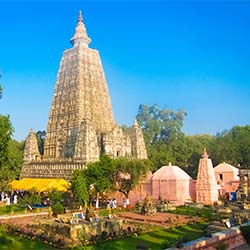
About The Brahmayoni Temple The Brahmayoni Temple is a sacred place of worship located in Bodhgaya, Bihar, India. It is a significant religious site for Hindus and Buddhists, as it is believed to be the spot where Lord Brahma, the creator of the universe, performed a yajna (sacrificial ritual) to seek blessings from Lord Vishnu. The temple attracts devotees and tourists from all over the world who come to seek blessings and experience the spiritual energy of this holy place. Architecture of Brahmayoni Temple The Brahmayoni Temple is an architectural marvel, with intricate carvings and sculptures that showcase the rich heritage and cultural significance of the region. The temple is built in the traditional Indian architectural style, with a central shrine dedicated to Lord Brahma. The main entrance of the temple is adorned with beautiful sculptures depicting scenes from Hindu mythology, while the interior is decorated with colorful frescoes and paintings that narrate the stories of the gods and goddesses. History The history of the Brahmayoni Temple dates back to ancient times, with references to the temple found in various religious texts and scriptures. It is believed that the temple was built by King Ashoka, the great Mauryan emperor, who was a devout follower of Buddhism. Over the centuries, the temple has undergone several renovations and additions, but its spiritual significance and sanctity have remained intact. Best Time To Visit The best time to visit the Brahmayoni Temple is during the winter months, from November to February, when the weather is pleasant and conducive for exploring the temple complex. The temple is also thronged by devotees during major Hindu festivals such as Diwali, Navratri, and Makar Sankranti, when special prayers and rituals are performed to seek divine blessings. How To Reach The Brahmayoni Temple is easily accessible by road, rail, and air. The nearest airport is Gaya Airport, which is well-connected to major cities in India. The temple is located just a few kilometers away from Bodhgaya, which is a popular pilgrimage site for Buddhists. Visitors can hire a taxi or take a bus from Bodhgaya to reach the temple. Significance Of The Brahmayoni Temple The Brahmayoni Temple holds immense religious and spiritual significance for Hindus and Buddhists alike. It is believed that worshipping at the temple can help devotees attain peace, prosperity, and spiritual enlightenment. The temple is also considered a sacred place for performing rituals and ceremonies, such as weddings, housewarming ceremonies, and anniversary celebrations. Visiting the Brahmayoni Temple is believed to cleanse the mind, body, and soul and bring divine blessings to the devotees. Overall, the Brahmayoni Temple in Bodhgaya is a place of immense beauty, history, and spiritual significance. It stands as a testament to the rich cultural heritage of India and attracts visitors from all walks of life who come seeking solace, enlightenment, and blessings from the divine.
Explore More
About Tibetan Refugee Market, Bodhgaya History, Architecture and Design The Tibetan Refugee Market in Bodhgaya was established in the 1960s by Tibetan refugees who fled their homeland following the Chinese invasion. The market serves as a hub for the Tibetan community to showcase their traditional crafts and goods. The architecture of the market is inspired by Tibetan design elements, with colorful prayer flags adorning the stalls and intricate wood carvings adding to the charm of the market. Best Time to Visit The best time to visit the Tibetan Refugee Market in Bodhgaya is during the winter months from October to March when the weather is cool and pleasant. This is also the peak tourist season, so you can expect a lively atmosphere at the market during this time. Cultural Significance The Tibetan Refugee Market holds significant cultural importance as it provides a platform for Tibetan refugees to showcase their traditional arts and crafts. It also serves as a reminder of the hardships faced by the Tibetan people and their resilience in preserving their culture and heritage. Pilgrimage Practices Many visitors to Bodhgaya include a visit to the Tibetan Refugee Market as part of their pilgrimage practices. The market offers a unique glimpse into Tibetan culture and traditions, making it a meaningful stop for those on a spiritual journey. Dress Code and Etiquette While there is no strict dress code at the Tibetan Refugee Market, it is important to dress modestly out of respect for the Tibetan culture and traditions. Visitors should also remember to remove their shoes before entering any of the stalls or shops. Activities and Experiences Visitors to the Tibetan Refugee Market can indulge in a variety of activities and experiences, such as shopping for traditional Tibetan handicrafts, sampling authentic Tibetan cuisine, and interacting with the friendly vendors. The market also hosts cultural performances and workshops, providing a deeper insight into Tibetan culture. Art and Religious Symbols The Tibetan Refugee Market is known for its exquisite handicrafts, including intricately carved wooden statues, colorful thangka paintings, and handmade prayer flags. These art pieces often feature religious symbols such as the Buddha, lotus flowers, and the Tibetan Om symbol, adding to the market's spiritual ambiance. Local Insights Visiting the Tibetan Refugee Market in Bodhgaya offers a unique opportunity to connect with the local Tibetan community and gain insights into their culture and way of life. By supporting the vendors and purchasing their handmade goods, visitors can contribute to the economic empowerment of the Tibetan refugees and help preserve their traditional arts and crafts.
Explore More6 Days Varanasi - Bodhgaya - Prayagraj Tour
6 Days/ 5 Night
Prayagraj - Varanasi - Bodhgaya - Sarnath
Varanasi - Bodhgaya - Prayagraj - Chitrakoot - Ayodhya Tour
9 Days/ 8 Night
Prayagraj - Varanasi - Bodhgaya - Ayodhya - Chitrakoot
4 Night - 5 Day Tour Of Bihar
5 Days/ 4 Night
Bodhgaya - Gaya - Nalanda - Rajgir
Banaras - Ayodhya - Prayagraj Trip For 8 Days
8 Days/ 7 Night
Prayagraj - Varanasi - Bodhgaya - Gaya - Ayodhya - Chitrakoot

About The Patan Devi Temple The Patan Devi Temple is a prominent Hindu temple located in Patna, Bihar. It is dedicated to the goddesses Durga and is believed to be one of the oldest temples in the city. The temple holds great religious significance among the locals and attracts a large number of devotees and tourists throughout the year. Architecture of Patan Devi Temple The architecture of the Patan Devi Temple is a blend of both modern and ancient styles. The temple is constructed in a simple yet elegant manner, with intricate carvings and designs on the walls and pillars. The main entrance of the temple is adorned with beautiful sculptures of gods and goddesses, giving it a majestic look. The sanctum sanctorum houses the idols of the goddesses Durga in their various forms, creating a serene and peaceful atmosphere for the devotees. History The history of the Patan Devi Temple dates back to ancient times. It is believed that the temple was originally built by the Mauryan emperor Ashoka in the 3rd century BC. Over the centuries, the temple has undergone several renovations and expansions, making it the magnificent structure that it is today. The temple holds a significant place in the religious and cultural heritage of Bihar and is considered a sacred site by the devotees. Best Time To Visit The best time to visit the Patan Devi Temple is during the festival of Navratri, which is dedicated to the worship of the goddess Durga. This is when the temple is beautifully decorated with flowers and lights, and the atmosphere is filled with devotional songs and chants. The festival attracts a large number of devotees from far and wide, making it a vibrant and lively celebration. How To Reach The Patan Devi Temple is located in the heart of Patna city, making it easily accessible by road, rail, and air. The nearest railway station is Patna Junction, which is well-connected to major cities across India. The temple is also easily accessible by road, with regular bus and taxi services available from the city center. For those traveling by air, the nearest airport is Jay Prakash Narayan International Airport, which is approximately 7 km away from the temple. Significance Of The Patan Devi Temple The Patan Devi Temple holds immense significance among the devotees, who believe that worshipping the goddess Durga here can bring blessings and prosperity. The temple is also associated with several myths and legends, making it a sacred site for religious rituals and ceremonies. It is believed that visiting the temple and offering prayers to the goddess can fulfill one's wishes and bring peace and happiness in life. The Patan Devi Temple is not just a place of worship but also a symbol of faith and devotion for the devotees. In conclusion, the Patan Devi Temple in Patna is a symbol of rich cultural heritage and religious significance in Bihar. The temple's majestic architecture, historical importance, and spiritual atmosphere make it a must-visit destination for those seeking blessings and peace. Whether you are a devotee or a tourist, a visit to the Patan Devi Temple is sure to leave you mesmerized by its beauty and tranquility.
Explore More
About Mahavir Mandir, Patna History The Mahavir Mandir in Patna, Bihar, is a renowned Hindu temple dedicated to Lord Hanuman. It was founded in the early 20th century by Swami Balananda, a saint and philanthropist. The temple has since become a significant religious and cultural landmark in the region, attracting thousands of devotees every year. Architecture and Design The Mahavir Mandir boasts a striking architectural design, with intricate carvings, colorful paintings, and a towering spire that reaches towards the sky. The temple complex is spread over a large area, with various shrines, prayer halls, and pavilions for worshippers to explore. The overall ambiance of the temple is one of peace, serenity, and devotion. Best Time to Visit - The best time to visit Mahavir Mandir is during the Hindu festival of Hanuman Jayanti, which falls in the month of Chaitra (March-April). - Another ideal time to visit is during the festival of Diwali, when the temple is beautifully decorated with lights and flowers. Cultural Significance The Mahavir Mandir holds immense cultural significance for the people of Bihar and beyond. It is believed that worshipping at this temple can bestow blessings of strength, courage, and protection from evil forces. The temple also serves as a hub for various religious and cultural events throughout the year, bringing communities together in celebration and prayer. Pilgrimage Practices Devotees visiting the Mahavir Mandir are encouraged to perform various rituals and practices to show their devotion to Lord Hanuman. This may include offering prayers, lighting incense sticks, and making offerings of flowers and fruits. Many pilgrims also participate in group chanting of Hanuman Chalisa, a sacred hymn dedicated to Lord Hanuman. Dress Code and Etiquette While there is no strict dress code enforced at the Mahavir Mandir, visitors are encouraged to dress modestly and respectfully. It is customary to remove shoes before entering the temple premises and to maintain a quiet and reverent demeanor while inside. Taking photographs or video recordings may be restricted in certain areas of the temple. Activities and Experiences Visitors to the Mahavir Mandir can engage in a variety of activities to enhance their spiritual experience. This may include attending daily prayer ceremonies, participating in guided tours of the temple complex, and seeking blessings from the resident priests. The temple also hosts cultural programs, religious discourses, and philanthropic initiatives for the benefit of the community. Art and Religious Symbols The Mahavir Mandir is adorned with exquisite artwork and religious symbols that pay homage to Lord Hanuman and other deities. Intricate carvings, vibrant paintings, and ornate sculptures can be found throughout the temple, depicting scenes from Hindu mythology and teachings. The presence of these artistic elements adds to the spiritual ambiance of the temple. Local Insights Visiting the Mahavir Mandir offers a unique opportunity to immerse oneself in the local culture and customs of Patna. Interacting with the temple staff, participating in religious ceremonies, and exploring nearby markets and eateries can provide valuable insights into the daily life of the residents. Many locals are eager to share their knowledge and experiences with visitors, creating a welcoming and enriching environment for all.
Explore More
About The Chaumukhi Mahadeva Temple The Chaumukhi Mahadeva Temple is located in Vaishali, Bihar, and is dedicated to Lord Shiva. This ancient temple is known for its unique architecture and historical significance. The temple gets its name from the four-faced (Chaumukhi) statue of Lord Shiva that is enshrined inside. Architecture of Chaumukhi Mahadeva Temple The Chaumukhi Mahadeva Temple is a fine example of early medieval Indian architecture. The temple is built in the Nagara style, with a square-shaped sanctum sanctorum and a pyramid-shaped shikhara (tower) above it. The temple is adorned with intricate carvings that depict scenes from Hindu mythology and legends. The four-faced statue of Lord Shiva is placed in the center of the sanctum, facing each of the four cardinal directions. History The Chaumukhi Mahadeva Temple is believed to have been built in the 9th century during the reign of the Licchavi dynasty. The temple stands as a testament to the rich cultural and religious heritage of Vaishali. It is said that the temple was constructed by a wealthy merchant in honor of Lord Shiva, who is worshipped as the destroyer of evil and the harbinger of prosperity. Best Time To Visit The best time to visit the Chaumukhi Mahadeva Temple is during the winter months from October to March when the weather is pleasant and ideal for exploring the historical sites in Vaishali. The temple also attracts a large number of devotees during the festival of Maha Shivaratri, which is celebrated with great fervor and devotion. How To Reach The Chaumukhi Mahadeva Temple is easily accessible by road, rail, and air. The nearest airport is in Patna, which is around 60 kilometers away from Vaishali. The nearest railway station is in Hajipur, which is well-connected to major cities in India. Visitors can also hire taxis or take buses from nearby cities like Patna or Muzaffarpur to reach the temple. Significance Of The Chaumukhi Mahadeva Temple The Chaumukhi Mahadeva Temple holds great religious significance for devotees of Lord Shiva. The four-faced statue of Lord Shiva is believed to symbolize his omnipresence and omnipotence. It is said that worshipping at this temple can bring peace, prosperity, and spiritual enlightenment to devotees. The temple also serves as a cultural heritage site, attracting historians, archaeologists, and art enthusiasts from around the world.
Explore More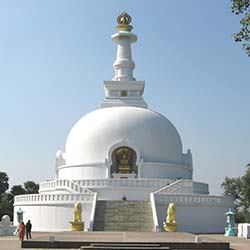
About Vishwa Shanti Stupa, Vaishali Vishwa Shanti Stupa, located in Vaishali, Bihar, is a symbol of peace and harmony. This majestic monument stands tall as a beacon of tranquility in the bustling town. The stupa is a unique blend of history, architecture, and cultural significance, making it a must-visit destination for tourists and pilgrims alike. History, Architecture, and Design Constructed in 1996 by the Nipponzan Myohoji sect of Japan, the Vishwa Shanti Stupa is a stunning example of Buddhist architecture. The stupa's design reflects the principles of peace and non-violence, with intricate carvings and sculptures adorning its walls. The stupa's construction is a testament to the strong cultural ties between India and Japan, symbolizing the enduring friendship between the two nations. Best Time to Visit The best time to visit Vishwa Shanti Stupa is during the winter months, from October to March. The weather is pleasant and ideal for exploring the stupa and its surroundings. Avoid visiting during the monsoon season, as heavy rains may disrupt your trip. Cultural Significance Vishwa Shanti Stupa holds immense cultural significance for Buddhists and people of all faiths. It serves as a place of meditation and reflection, where visitors can experience inner peace and spiritual enlightenment. The stupa's serene ambiance and beautiful surroundings make it a popular pilgrimage site for those seeking solace and tranquility. Pilgrimage Practices Visitors to Vishwa Shanti Stupa are encouraged to participate in meditation sessions and prayer rituals conducted by the resident monks. Pilgrims can also offer prayers and light candles at the stupa, seeking blessings and guidance for their spiritual journey. It is essential to maintain silence and reverence while visiting the stupa, to respect its sacredness. Dress Code and Etiquette While visiting Vishwa Shanti Stupa, it is advisable to dress modestly and respectfully. Both men and women should wear clothing that covers their shoulders and knees, out of respect for the religious significance of the site. Visitors are also expected to remove their shoes before entering the stupa premises, as a sign of reverence and humility. Activities and Experiences At Vishwa Shanti Stupa, visitors can engage in a variety of activities that promote peace and harmony. From attending meditation workshops to participating in cultural events, there are ample opportunities to immerse yourself in the spiritual ambiance of the stupa. Don't miss the chance to witness the evening prayer ceremony, where the stupa is illuminated with glowing lights and chants fill the air. Art and Religious Symbols The Vishwa Shanti Stupa is adorned with intricate artworks and religious symbols that convey deep spiritual meanings. From Buddha's teachings to symbols of peace and enlightenment, the stupa's architecture is a visual representation of Buddhist philosophy. Each carving and sculpture tells a story of compassion, wisdom, and inner harmony, inspiring visitors to seek a higher state of consciousness. Local Insights Exploring Vishwa Shanti Stupa offers a unique opportunity to learn about the local culture and traditions of Vaishali. Interact with the resident monks and locals to gain insights into the history and significance of the stupa. Visit nearby temples and markets to experience the vibrant essence of Vaishali, and savor traditional dishes at local eateries for a taste of authentic Bihar cuisine.
Explore More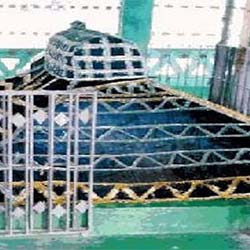
About The Ghuran Peer Baba The Ghuran Peer Baba shrine is a revered Sufi shrine located in Bhagalpur, Bihar. It is dedicated to a holy saint, Ghuran Peer Baba, who is believed to have possessed miraculous powers that can fulfill the wishes of his devotees. The shrine attracts a large number of devotees, both Muslims and Hindus, who come seeking blessings and solutions to their problems. Architecture of Ghuran Peer Baba The architecture of the Ghuran Peer Baba shrine is a beautiful blend of Islamic and Indian styles. The shrine is adorned with intricate carvings, calligraphy, and colorful tiles. The main structure houses the tomb of Ghuran Peer Baba, surrounded by marble pillars and arches. The courtyard is spacious and peaceful, providing a serene atmosphere for prayer and reflection. The entire complex is well-maintained and exudes a sense of tranquility and spiritual energy. History The history of the Ghuran Peer Baba shrine dates back several centuries. It is believed that Ghuran Peer Baba was a mystic saint who lived in Bhagalpur and dedicated his life to serving humanity. His selfless acts of kindness and healing powers earned him a reputation as a holy man. After his passing, a shrine was built in his honor to commemorate his legacy and continue his spiritual work. Best Time To Visit The best time to visit the Ghuran Peer Baba shrine is during the annual Urs (death anniversary) celebrations, which take place in the Islamic month of Safar. This is a special time when the shrine is adorned with lights, flowers, and offerings, and devotees come together to pray, recite hymns, and seek blessings. The atmosphere is festive and vibrant, with a sense of community and spiritual unity. How To Reach The Ghuran Peer Baba shrine is located in Bhagalpur, Bihar, making it easily accessible by road, rail, and air. The nearest airport is Lok Nayak Jayaprakash Airport in Patna, which is about 180 kilometers away. The Bhagalpur Railway Station is well-connected to major cities like Delhi, Kolkata, and Patna, making it convenient for visitors to reach the shrine by train. Local buses and taxis are also available for transportation within Bhagalpur. Visitor Tips 1. Dress modestly and respectfully when visiting the shrine, as it is a sacred place of worship. 2. Remove your shoes before entering the shrine and maintain silence and decorum during prayers. 3. Carry offerings like flowers, sweets, or incense to present at the tomb of Ghuran Peer Baba. 4. Seek permission before taking photographs or videos inside the shrine, as some areas may be restricted. 5. Respect the customs and traditions of the shrine, and avoid any behavior that may be considered disrespectful. 6. Plan your visit during the Urs celebrations to experience the spiritual energy and community spirit of the shrine. By following these tips and guidelines, visitors can have a meaningful and enriching experience at the Ghuran Peer Baba shrine in Bhagalpur.
Explore More
About Digambar Jain Mandir, Bhagalpur History The Digambar Jain Mandir in Bhagalpur is a significant place of worship for the Jain community. It was established several centuries ago and has since been a center of spirituality and religious practices for followers of Jainism in the region. The temple has undergone numerous renovations and expansions over the years, making it a blend of ancient and modern architectural styles. Architecture and Design The temple boasts a stunning architectural design that is a testament to the skilled craftsmanship of its builders. The intricate carvings, majestic domes, and vibrant colors of the temple's facade make it a sight to behold. The interior of the temple is adorned with ornate sculptures and paintings that depict stories from Jain mythology. Best Time to Visit 1. The best time to visit the Digambar Jain Mandir is during the months of October to March when the weather is pleasant. 2. Avoid visiting during the monsoon season as the roads leading to the temple may be slippery and dangerous. Cultural Significance The Digambar Jain Mandir holds immense cultural significance as it is a place where followers of Jainism come to seek spiritual guidance and perform religious rituals. The temple is also a hub of cultural activities and festivals that celebrate the teachings of Lord Mahavira. Pilgrimage Practices Visitors to the Digambar Jain Mandir are encouraged to participate in the various religious practices and rituals that take place within the temple premises. These practices include meditation, chanting of Jain mantras, and offering prayers to the deities. Dress Code and Etiquette Visitors are expected to dress modestly when visiting the Digambar Jain Mandir. It is advisable to wear clothes that cover the shoulders and knees out of respect for the religious traditions of the temple. Additionally, visitors are required to remove their shoes before entering the temple premises. Activities and Experiences Visitors to the Digambar Jain Mandir can take part in a variety of activities and experiences that are designed to enhance their spiritual journey. These include attending religious discourses, participating in puja ceremonies, and exploring the temple's beautiful gardens and surroundings. Art and Religious Symbols The temple is adorned with intricate sculptures and paintings that depict scenes from Jain mythology. Visitors can admire the exquisite artwork and learn more about the religious symbols and motifs that are significant to the Jain faith. Local Insights Visitors to the Digambar Jain Mandir can gain valuable insights into the local Jain community's customs and traditions. They can interact with the temple's priests and devotees, learn about the history and significance of the temple, and immerse themselves in the rich cultural heritage of Bhagalpur.
Explore More
Makhdum Kund or Makhdoom Kund is a sacred spring and dargah of a Muslim saint, Makhdum Shah. He was a Sufi saint who spent twelve years in the woods of Rajgir. He was an extraordinary individual who helped the locals without expecting anything. Many claimed that he had miraculous powers for healing the long terms ailments. Why Is It Famous?Makhdum Kund is known for its sanctity. This place is equally visited by the Hindu & Muslim sect in Rajgir. There is a small place where the dargah of Makhdum Shah is located. Muslims & Hindus regularly visit this site and seek his blessings. The pond known by the same name is regarded as sacred because people claim that the water of the pond never dries and is blessed by divine powers. The festivals of Eid-Ul-Fitr, Holi, and Diwali are celebrated here. Best Time To Visit:-Makhdum Kund is visited on a high scale during winters. Since the water remains warm throughout the year, as claimed to be blessed, many pilgrims do not miss a chance to take a holy dip in it. Nearest Railway Station - Rajgir Railway StationNearest Airport - Patna Airport
Explore More
About The Surya Mandir Temple The Surya Mandir Temple, located in Aurangabad, is a magnificent temple dedicated to the Sun God, Surya. It is a significant religious site for Hindus and draws devotees and tourists alike from all over the country. The temple is known for its stunning architecture, intricate carvings, and spiritual ambiance, making it a must-visit destination for anyone interested in history, culture, and spirituality. Architecture of Surya Mandir Temple The Surya Mandir Temple is renowned for its breathtaking architecture that reflects the rich heritage and craftsmanship of ancient India. The temple is built in the Hemadpanthi style of architecture, which is characterized by its use of black basalt stone and intricate carvings. The main sanctum of the temple houses a life-size idol of the Sun God, Surya, surrounded by intricate carvings depicting various mythological stories and scenes from Hindu scriptures. The temple also has a pillared hall and a spacious courtyard, adding to its grandeur and beauty. History The Surya Mandir Temple was built in the 13th century during the reign of the Yadava dynasty. It was commissioned by King Bhimdev, who was a devout follower of the Sun God, Surya. The temple has stood the test of time and has witnessed the rise and fall of empires, making it a living testimony to the rich history and cultural heritage of Aurangabad. Best Time To Visit The best time to visit the Surya Mandir Temple is during the winter months, from November to February, when the weather is pleasant and suitable for exploring the temple complex. The temple can get crowded during festivals and special occasions, so it is advisable to plan your visit accordingly to avoid the rush and enjoy the spiritual ambiance of the temple. How To Reach The Surya Mandir Temple is located in Aurangabad, Maharashtra, and is easily accessible by road, rail, and air. The nearest airport is Aurangabad Airport, which is well-connected to major cities in India. The temple is also well-connected by road, and visitors can hire taxis or take public transportation to reach the temple complex. For those traveling by train, Aurangabad Railway Station is the nearest railhead, and from there, one can hire a taxi or take a bus to reach the temple. Significance Of The Surya Mandir Temple The Surya Mandir Temple holds great religious significance for Hindus, as it is dedicated to the Sun God, Surya, who is considered the source of life and energy. Devotees visit the temple to offer prayers and seek blessings for health, prosperity, and well-being. The temple also attracts history enthusiasts, art lovers, and tourists who are captivated by its architectural beauty and spiritual aura. Visiting the Surya Mandir Temple is not just a religious experience but also a journey through time and history, offering a glimpse into the rich cultural heritage of Aurangabad and India. Overall, the Surya Mandir Temple in Aurangabad is a gem of a religious site that stands as a testament to the rich history, culture, and architectural brilliance of ancient India. With its stunning architecture, spiritual ambiance, and historical significance, the temple is a must-visit destination for anyone seeking a memorable and enriching experience.
Explore More